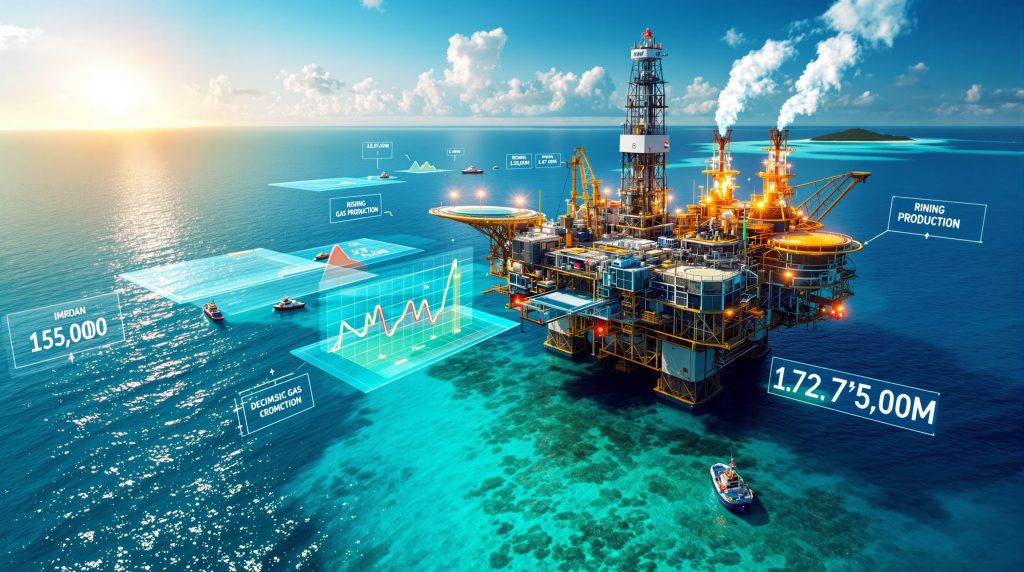What Is the Significance of the New Gas Discovery in the Andaman-Nicobar Basin?
The recent natural gas discovery in the Andaman-Nicobar Basin marks a significant milestone in India's pursuit of energy self-reliance. Located off the east coast of the Andaman Islands, the Sri Vijayapuram-2 well in Andaman Block AN-OSHP-2018/1 has yielded promising results that could reshape the nation's energy landscape. This discovery is particularly noteworthy as it occurred at a water depth of 295 meters, with initial production testing conducted in the range of 2,212-2,250 meters, revealing a high methane content of approximately 87%.
This breakthrough represents the first major output from Prime Minister Narendra Modi's 'Samudra Manthan' ('Churning of the Ocean') initiative, a strategic mission designed to explore India's untapped deepwater oil and gas potential. The block, awarded under the Open Acreage Licensing Policy (OALP) Bid Round II in 2019, is being developed through a three-well exploration campaign initiated by Oil India in 2024.
From a strategic perspective, this discovery serves multiple national objectives. It validates India's long-term investment in offshore exploration while potentially reducing dependency on imported natural gas. According to Hardeep Singh Puri, India's Minister of Petroleum and Natural Gas, the discovery confirms the geological promise of India's deepwater regions and may encourage further investments in exploration drilling.
Beyond the immediate energy implications, this find aligns with India's broader climate commitments. Natural gas, being a relatively cleaner fossil fuel compared to coal, can support India's transition toward lower-carbon energy sources for power generation and industrial applications. The high methane content of this particular discovery enhances its value as an efficient energy source.
Industry experts suggest this discovery could serve as a valuable stepping stone toward increased domestic upstream production. However, its transformative impact will ultimately depend on the size of reserves, development speed, extraction costs, and energy security strategies.
How Does This Discovery Impact India's Domestic Gas Production?
What Is the Current Status of Domestic Natural Gas Supply?
India's natural gas sector has faced significant challenges in recent years. Despite growing demand across industrial, power generation, and residential sectors, domestic production has struggled to keep pace. The resulting gap has been filled through increasing imports, primarily in the form of liquefied natural gas (LNG), which has implications for both energy security and the national economy.
The country's domestic gas production has experienced a concerning trend of plateauing or declining rig activity over the past decade. This production challenge comes at a particularly inopportune time as India aims to increase the share of natural gas in its overall energy mix from the current level to 15% as part of its energy transition strategy.
Currently, India imports over half of its natural gas requirements, creating vulnerability to international price volatility and supply disruptions. These imports result in substantial foreign exchange outflows and make domestic industries dependent on external energy sources.
| Year | Production (bcm) | Consumption (bcm) | Import % |
|---|---|---|---|
| 2020 | 27.9 | 59.7 | 53.3% |
| 2021 | 28.5 | 63.2 | 54.9% |
| 2022 | 29.1 | 65.8 | 55.8% |
| 2023 | 28.6 | 68.4 | 58.2% |
| 2024 | 28.2 | 70.1 | 59.8% |
What Potential Does the Andaman-Nicobar Basin Hold for India's Gas Future?
The Andaman-Nicobar Basin represents one of India's most promising yet historically underexplored offshore regions. Geological studies indicate similarities between this basin and other productive areas such as the Krishna-Godaveri and Mahanadi basins, both of which have yielded significant hydrocarbon discoveries.
What makes the Andaman-Nicobar Basin particularly intriguing is that despite its geological promise and significant discoveries in analogue basins, it has seen only a handful of exploration wells over several decades. This limited exploration activity underscores the historically cautious approach companies have taken, primarily due to technical challenges, high costs, and the lack of high-quality deepwater seismic data.
The recent discovery could fundamentally change this perception. By validating the basin's hydrocarbon potential, it may trigger increased interest from both national and international operators. Energy analysts suggest that the discovery could turn the basin into a significant contributor to India's domestic gas supply, though much depends on the size of the reservoir and its production potential.
ONGC's earlier discoveries in the Mahanadi Basin (Konark and Utkal) provide encouraging parallels. These fields, once fully developed, are expected to add meaningful volumes to India's production profile. If the Andaman-Nicobar Basin follows a similar trajectory, India could witness a substantial boost to domestic output within this decade.
Which Technical and Policy Factors Enable Deepwater Gas Discoveries in the Region?
What Advanced Exploration Techniques Were Utilized?
The success in the Andaman-Nicobar Basin can be attributed to significant advancements in deepwater exploration technology. Modern 3D seismic imaging techniques have proven crucial in identifying promising geological structures beneath the seabed. These high-resolution surveys allow geologists to visualize subsurface formations with unprecedented clarity, substantially improving the chances of successful drilling.
Deepwater drilling itself represents a technical challenge requiring specialized equipment and expertise. The Sri Vijayapuram-2 well, drilled to a target depth of 2,650 meters in waters 295 meters deep, demonstrates India's growing capabilities in this demanding sector. Such operations involve sophisticated drilling vessels, advanced well control systems, and specialized equipment designed to function reliably in harsh marine environments.
The lack of high-quality deepwater seismic data has historically been a significant impediment to exploration in the Andaman-Nicobar Basin. This recent discovery is expected to spur more comprehensive 3D seismic surveys not just in this basin but in other under-explored deepwater areas across India's exclusive economic zone.
Collaborative partnerships have also played a crucial role. The July 2025 memorandum of understanding between ONGC and BP to collaborate on drilling stratigraphic wells in multiple Indian offshore sedimentary basins (including Andaman, Mahanadi, Saurashtra, and Bengal) exemplifies how technical expertise is being shared to enhance geological understanding and unlock untapped hydrocarbon potential.
What Are the Key Policy and Regulatory Innovations?
India's Open Acreage Licensing Policy (OALP) represents a significant departure from the country's previous licensing regimes. Under OALP, introduced in 2017, companies can identify areas of interest and apply for exploration licenses year-round, rather than waiting for scheduled bidding rounds. This market-driven approach has enhanced flexibility and allowed companies to focus on areas they find most prospective.
The Andaman Block AN-OSHP-2018/1, which yielded this discovery, was awarded under OALP Bid Round II in 2019. This timing illustrates how quickly the policy has begun to deliver meaningful results. The OALP framework includes revenue-sharing contracts that provide more operational freedom to contractors while ensuring the government receives an appropriate share of resource value.
Several key governmental bodies have coordinated to enable this progress, including the Ministry of Petroleum and Natural Gas, the Directorate General of Hydrocarbons (DGH), and the national oil companies. Their collaborative efforts have streamlined approval processes, improved data accessibility, and created a more conducive environment for both domestic and international investment.
Industry experts suggest that continued regulatory improvements will be necessary to fully capitalize on India's offshore potential. In particular, enhancing transparency in data sharing and establishing clear environmental protocols for deepwater operations will be essential to attract sustained international oil company interest in exploring India's frontier basins.
What Are the Economic and Environmental Implications of Andaman-Nicobar Offshore Development?
How Might This Discovery Affect India's Import Dependence and Energy Security?
The potential impact of the Andaman-Nicobar gas discovery on India's energy security could be substantial. With the country currently importing nearly 60% of its natural gas requirements, any significant domestic production increase would reduce external dependence and enhance energy sovereignty.
Beyond the direct supply implications, new gas reserves could provide India with a strategic buffer against global price volatility. This increased domestic production strengthens the country's negotiating position in international energy markets and helps insulate the economy from external supply disruptions.
The economic benefits extend beyond direct energy costs. Natural gas serves as a critical feedstock for industries such as fertilizer manufacturing, petrochemicals, and various manufacturing sectors. Reliable domestic supplies at predictable prices can enhance the competitiveness of these industries, potentially stimulating broader economic growth and job creation.
"Natural gas is a cleaner alternative to coal, supporting India's climate goals in power and industry sectors. Each cubic meter of domestic gas that displaces imported LNG also helps reduce India's carbon footprint due to the elimination of energy-intensive liquefaction, shipping, and regasification processes."
From a strategic perspective, reducing dependence on imported energy improves India's trade balance and conserves foreign exchange reserves. According to financial analysts, for every 10% reduction in gas imports, India could save approximately $3-4 billion annually in foreign exchange outflows at current price levels.
What Infrastructure and Investment Are Needed Next?
Developing the Andaman-Nicobar Basin will require substantial infrastructure investment. Initial requirements include production platforms designed for the specific water depths and environmental conditions of the region. These structures must withstand potential cyclonic conditions while providing safe, reliable operations.
Pipeline infrastructure presents a particular challenge due to the basin's relative isolation from existing gas transmission networks. Options include subsea pipelines connecting to the mainland or potentially floating LNG facilities that would allow gas to be liquefied offshore and transported by tanker to various markets.
Capital requirements for full-scale development could range from $5-10 billion, depending on reserve size and development complexity. This investment would be phased over several years, with initial production potentially achievable within 3-5 years of final investment decision.
The scale of investment required highlights the importance of attracting diverse funding sources, including international capital. Financial analysts suggest that clear fiscal terms, contract stability, and transparent regulations will be essential to mobilize the necessary investment. Partnerships between national oil companies and international operators with deepwater expertise will likely play a central role in development strategies.
What Are the Environmental and Social Considerations?
Deepwater exploration and production in the ecologically sensitive Andaman-Nicobar region demands rigorous environmental safeguards. The area is known for its rich marine biodiversity, including coral reefs and endangered species, necessitating careful impact assessment and mitigation strategies.
Potential environmental risks include impacts on marine ecosystems during exploration and production, the possibility of accidental releases, and greenhouse gas implications throughout the production lifecycle. Advanced technologies for minimizing environmental footprint, including zero-discharge operations and robust emergency response capabilities, will be essential.
From a climate perspective, increased natural gas production aligns with India's nationally determined contributions (NDCs) under the Paris Agreement. Natural gas produces approximately 50-60% fewer carbon emissions than coal when used for power generation, making it a valuable transition fuel as renewable energy capacity expands.
Social considerations include benefits for local communities through employment opportunities, infrastructure development, and potential revenue sharing. The Andaman and Nicobar Islands' unique social and cultural heritage requires respectful engagement and consultation with local populations regarding development plans.
What Challenges Could Delay or Limit the Impact of These Discoveries?
The path from discovery to production faces multiple potential hurdles. Economic challenges include accurately determining reserve size, which requires additional appraisal wells and extensive testing. Current estimates suggest development costs in the Andaman-Nicobar Basin could be 30-40% higher than in established production regions due to limited infrastructure and logistical complexities.
Data quality represents another significant challenge. The lack of comprehensive high-quality seismic and geological data creates uncertainty in development planning and reserve estimation. While the recent discovery provides encouraging signs, extensive additional data gathering will be necessary to optimize development strategies.
Regulatory clarity remains essential for project advancement. International investors seek transparent, stable fiscal terms and streamlined approval processes. While India has made significant progress in these areas through the OALP framework, continued refinements to contract terms and approval workflows could further enhance investor confidence.
Operational challenges are substantial in deepwater environments. The Andaman-Nicobar region experiences seasonal cyclonic activity, and operations must be designed to withstand harsh marine conditions. Deepwater drilling requires specialized vessels and equipment that often have limited availability and high day rates.
Environmental compliance presents both technical and regulatory challenges. Developing effective environmental management plans that satisfy both Indian regulations and international standards requires detailed baseline studies, impact assessments, and continuous monitoring programs.
| Factor | India's Challenge | Global Benchmark |
|---|---|---|
| Costs | $12-15/MMBtu for new basin development | $8-10/MMBtu in mature regions |
| Data Availability | Limited comprehensive 3D seismic coverage | Extensive multi-generation surveys in mature basins |
| Environmental | Sensitive marine ecosystems requiring careful management | Established protocols in regions like North Sea, Gulf of Mexico |
| Policy Support | Improving through OALP, but evolving | Mature stable frameworks in Norway, UK, Australia |
How Will the Offshore Gas Market in the Region Evolve?
Will the Andaman-Nicobar Basin Attract International Capital & Expertise?
The Andaman-Nicobar Basin's potential to attract international capital and expertise hinges on several factors. The scale and productivity of this initial discovery will influence investment decisions. If appraisal confirms substantial commercially viable reserves, international oil companies (IOCs) with deepwater expertise are likely to express increased interest.
Recent partnerships signal growing international engagement. The July 2025 memorandum of understanding between ONGC and BP specifically includes the Andaman Basin among its focus areas. This collaboration aims to enhance geological understanding and unlock untapped hydrocarbon potential, potentially leading to additional discoveries.
Technical challenges in the basin present both obstacles and opportunities for international collaboration. IOCs with advanced deepwater capabilities can offer valuable expertise in areas such as high-resolution seismic imaging, complex drilling operations, and subsea development solutions. These capabilities complement the regional knowledge and operational capacity of India's national oil companies.
Fiscal terms will play a decisive role in attracting international investment. While the OALP framework has improved India's competitiveness, continued enhancements to contract stability and economic terms could further stimulate foreign direct investment in the sector. Companies evaluate global opportunities based on risk-adjusted returns, making competitive fiscal terms essential for attracting capital.
Knowledge transfer represents a significant potential benefit of international partnerships. Collaborations between Indian companies and international operators facilitate technology transfer, skills development, and adoption of global best practices. This knowledge exchange strengthens India's domestic capabilities while accelerating field development.
What Are the Next Frontiers for Indian Offshore Exploration?
The Andaman-Nicobar discovery may catalyze broader exploration efforts across India's offshore basins. Several other underexplored areas show promising geological characteristics that warrant further investigation.
The Saurashtra Basin off India's west coast represents one such frontier. Limited exploration has yielded encouraging results, suggesting potential for both oil and gas discoveries. The basin's proximity to existing infrastructure and markets enhances its economic attractiveness.
The Bengal Basin, straddling India's eastern maritime border, presents another significant opportunity. Geological studies indicate similarities to productive basins in Southeast Asia, and recent seismic surveys have identified several promising structures meriting further investigation.
Strategic initiatives to encourage exploration include improved data access, dedicated geophysical surveys, and tailored fiscal incentives for frontier areas. The government's proposed development of a National Data Repository aims to enhance data availability and quality, reducing exploration uncertainty.
The role of national oil companies remains central to India's exploration strategy. ONGC and Oil India will continue to lead exploration efforts, but their effectiveness may be enhanced through targeted partnerships with private and foreign entities that bring complementary capabilities and resources.
Frequently Asked Questions
What makes the Andaman-Nicobar Basin geologically promising?
The Andaman-Nicobar Basin features thick sedimentary sequences deposited over millions of years, creating multiple potential reservoir and source rock intervals. Its geological history includes periods of restricted marine conditions favorable for organic matter preservation, potentially generating substantial hydrocarbon volumes. Structural features such as anticlines, fault blocks, and stratigraphic traps provide numerous potential accumulation mechanisms.
How fast can new finds reduce India's import bill?
Typically, deepwater gas discoveries require 4-7 years from discovery to first production. Initial volumes are often modest, with production ramping up over several years as additional wells are drilled. Meaningful import reduction might begin in the late 2020s, with more substantial impacts possible in the 2030s if multiple discoveries are developed. The precise timeline depends on reserve size, development complexity, and infrastructure requirements.
What is the timeline for production after a discovery?
Following discovery, companies typically conduct appraisal drilling to determine reservoir size and characteristics, a process lasting 1-2 years. Conceptual engineering and front-end engineering design require another 1-2 years. Final investment decision precedes procurement and construction, which typically spans 2-3 years for deepwater projects. Therefore, first production might reasonably be expected 5-7 years after initial discovery, though accelerated timelines are possible with expedited regulatory approvals.
How does this fit with India's low-carbon transition plans?
Natural gas plays a dual role in India's energy transition strategy. In the near term, it supports emissions reduction by displacing more carbon-intensive fuels like coal in power generation and industrial applications. Longer-term, gas infrastructure can potentially be repurposed for low-carbon gases such as hydrogen or biomethane. India's nationally determined contributions under the Paris Agreement specifically identify expanding natural gas usage as a strategy to reduce emissions intensity while supporting economic growth.
Conclusion: What Does the New Andaman-Nicobar Gas Find Signal for India's Energy Future?
The Andaman-Nicobar discovery represents a potential turning point in India's domestic gas production narrative. This find demonstrates the effectiveness of recent policy reforms while validating the geological potential of India's deepwater regions. If successfully developed, it could mark the beginning of a new chapter in the country's energy history, one characterized by greater self-reliance and enhanced energy security.
Several critical success factors will determine whether this discovery fulfills its transformative potential. Sustained investment in exploration and production infrastructure will be essential, requiring both public and private capital. Continued regulatory reforms that enhance transparency, contract stability, and operational flexibility will help attract international expertise and investment strategy insights. Environmental management practices that protect sensitive marine ecosystems while enabling responsible development will ensure sustainable operations.
Looking forward, this discovery may herald broader changes in India's energy landscape. A thriving domestic gas industry could support industrial growth, enhance power reliability, and facilitate the country's transition toward lower-carbon energy sources. It may also strengthen India's standing in global energy markets, transforming the country from primarily an importer to a more balanced participant with growing domestic production.
While significant challenges remain, the Andaman-Nicobar discovery provides tangible evidence of progress toward India's long-held goal of enhancing energy self-sufficiency. The coming years will reveal whether this represents the first step toward a fundamental transformation of India's energy future or merely an incremental improvement in domestic supply. What remains clear is that the geological potential exists; realizing it will depend on coordinated efforts across technical, financial, regulatory, and environmental dimensions.
Furthermore, the implications extend beyond India's borders, as successful development could potentially influence regional energy export challenges and shift existing trade dynamics. In addition, this development comes at a time when many countries are reassessing their energy policies, with the Alaska drilling shift representing just one example of the global recalibration of hydrocarbon exploration strategies.
Seeking Early Alerts on the Next Major Mineral Discovery?
Discovery Alert's proprietary Discovery IQ model instantly notifies investors of significant ASX mineral discoveries, transforming complex data into actionable insights for both short-term traders and long-term investors. Explore historic returns of major mineral finds by visiting our dedicated discoveries page and position yourself ahead of the market with our 30-day free trial.




